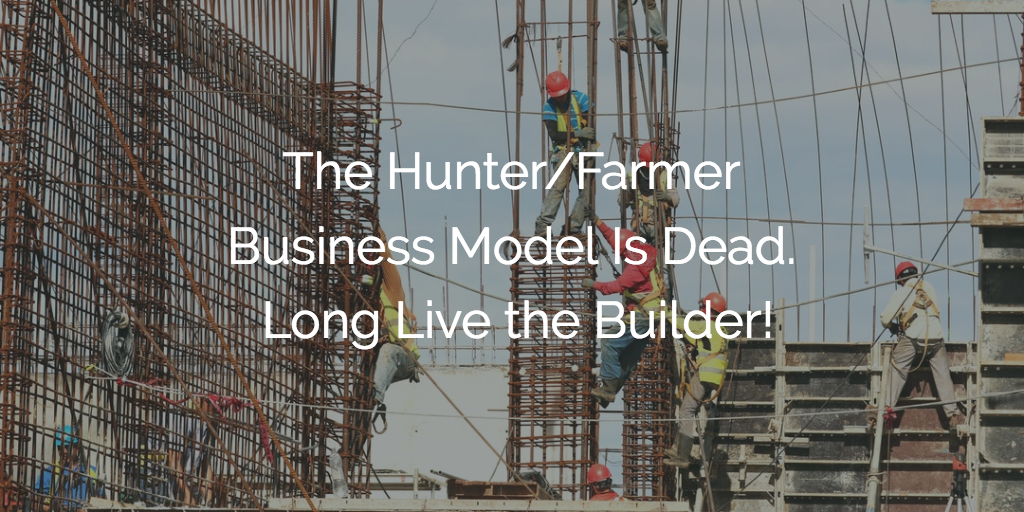I cringe every time I’m in a conversation with a Sales leader talking about Customer Success and they make the familiar reference to our outbound Sales team as “Hunters” and the CS team as “Farmers.”
If you can relate, this post is for you!
It’s time to scrap this notion of “hunting” and “farming” as the dominant models for how we work with customers. Customer Success has exploded as a function because every industry has changed—or is in the process of changing. In the same way, it’s time to change our mindset from thinking purely about Hunters and Farmers and welcome a new model: “Builders.”
Don’t get me wrong. I like to eat, and I know a lot of Farmers (real and metaphorical), and they’re really good people. But the Farmer metaphor is old and implies the wrong things when I think about Customer Success (or at least the way we think about it at Axonify) and it doesn’t reflect the direction I intend to go in Customer Success.
This archaic model is self-serving in that it glorifies the Hunter. It implies “organic growth” with proper nurturing by the “industrious farmer.” It ignores the fact that complications arise and needs change. My experience being part of growing Axonify by 10x over the last four years has informed me that as good as our product and teams are, it isn’t a matter of simply harvesting a healthy crop year after year. Anyone in Customer Success who has real revenue accountability knows this.
The Builder Model
Let’s dig into the Builder model a little bit:
Farmers are given a field to work and a crop to grow and nurture.
Builders, by contrast, are given a set of raw materials, tools, and a team to get the job done. (If we’re lucky, we get a blueprint of what the tenant wants.)
But when digging the foundation the team finds out there’s an underground stream running through the middle of the property. Once the first story is complete, the tenant decides they actually want the kitchen on the other side. And once the project is done, your tenant thanks you, tells you they just got a new job, are moving out of town and have sold the place to someone new. That new person arrives, and tells you they hate the granite countertops (among other things).
Let’s move beyond initial construction. We get the house built and your tenant had a good year or two in in the home. Well, who’s ever lived in a place and not wanted to change a thing or two? Knock down a wall. Put on an addition. Upgrade a feature or two.
To stay in business, the Builder needs a prescriptive, long term plan for their tenants. Purely reacting to requests will only lead to a home that is disjointed, shoddy and ultimately falls apart. An effective Builder understands what their tenant needs and can offer recommendations to guide the long term design, understanding where being flexible won’t impact the over all integrity of the structure.
An effective Builder needs to be connected to the best electrician, plumber, engineer, and designer in the city. They aren’t experts in every one of these areas—their expertise is in understanding what the customer needs and enabling them to realize their vision. And even more critically, once that dream is realized, they’re casting a vision for the next phase of the project: “Now that the kitchen is done, imagine what a side door exit would look like, especially if it led to an outdoor kitchen…”
In summary, Builders take responsibility for the long-term, ever-evolving needs of their customer—the tenant. They constantly reaffirm value, stay on top of industry trends, and are always looking for opportunities to sell the next project. Tenants who are ever-changing but are given a path to realize value aren’t likely to go anywhere. And it warrants mention that those tenants who have had a successful project are happy to refer you to their friends.
To bring the metaphor into reality, let’s identify three main strategic differences between Builders and Farmers in the world of Customer Success:
- Builders are presciptive; Farmers are reactive.
- Builders coordinate across functions; Farmers are siloed.
- Builders create value; Farmers collect value
The Problem With Farming Metaphors
At the risk of being offensive I’m going to be blunt. “Farming” might work as a model and metaphor for some Customer Success organizations that have operated in transactional segments of the industry where the needs of customers are largely homogenous and don’t radically change year over year. Here, CSMs truly do simply “nurture” their customers, but don’t ultimately have any real accountability for revenue, especially when things go wrong. I don’t see this as the model for the future.
CSMs and Customer Success leaders must shake off the notion that they are there to “nurture” a customer and “make them happy,” yielding a healthy annual crop year after year. The imperative of any effective CSM and CS organization is that they are a driver of value and growth for their customer. They need to be prescriptive in their approach, constantly looking for ways to grow and evolve how the customer is using (and ultimately getting value) from their product or service. The people we work with, needs of the business, and preferences of the customer are constantly changing—we can either react to that change, or we can take leadership and own the change.
It is time to scrap the Hunter/Farmer distinction. If you want to succeed as a CSM or effectively lead the CS function in your company (and ultimately enable your subscription-based business to survive), CSMs and CS leaders need to fundamentally think of themselves as Builders and embrace the heightened responsibility that entails and that should be expected of us.
Get a personalized, prescriptive plan to improve your CS org

